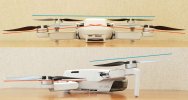I had asked whether there is a 3rd party prop that would work without suffering from the problem [...]
Others have asked that as well, suggesting that maybe stiffer carbon fibre blades would be more resistant to this bending. However...
Here's the problem. It's because of the geometry of the motor angles, particularly the rear motors.
When viewed from the rear, you can see the front motors (blue line) are level and horizontal, while the
rear motors (red lines) are noticeably
canted outboard. When viewed from the side, the front motors are mounted at an angle canted rearward, while the rear motors are level horizontally. That, in itself, is no problem. It's done deliberately for reasons of flight stability and responsiveness.

It's only a problem when the Mini's arms are folded with the blades stowed meshed together
laterally across the body of the Mini.
Because of the outboard canted angle of the rear motors, fresh non-deformed blades will cross in an X shape. They
cannot be meshed to fold together unless one side or the other is bent down to fit under the opposite side's blades.
To force the blades into this crossed position, as instructed by DJI's label in the bottom of the FlyMore Case, the tips of the blades from one side must bend to fit under the opposite blades. Compare the undeflected height of the tip of blade #1 versus the tip of blade #2 that is being bent down in this image.

If stored in this position for any length of time, the blade eventually becomes permanently drooped. The droop alone is not what's causing the problem though. Look closely at the image above. As the tip of blade #2 is forced down, the trailing edge near the root of the blade contacts the body of the Mini. So, as the tip is bent
down, the trailing edge is pressed
up.
That
twists the pitch angle of the blade.

The trailing edge at the root of the blade is quite strong and not easily deflected. However, the tip of the blade is very easily deformed. From the image above you can see that pushing down on the tip of the blade, while supporting the trailing edge at the blade's root, will twist the blade so that the leading edge at the tip curls down.
As the motor spins, the tip of the blade moves through the air significantly faster than the root of the blade. If the tip is bent down and twisted sufficiently it will no longer produce lift. If sufficiently bent, the tip will eventually even generate negative lift, thereby countering any useful lift still being produced at the root of the blade. The flight controller compensates for this lack of lift by spinning the motor faster, until ultimately the motor is incapable of spinning any faster.
Stiffer blades will
not cure the issue,
if one continues to store the props with blades crossed. Because of the way the rear motors are canted outboard, it would be impossible to cross the stiffer blades for storage without twisting and bending the motor arms instead.
The answer is to store the Mini with its arms open. If you must fold the arms, position the blades longitudinally alongside the body of the Mini, or even at an angle without the tips crossing.
Even without the weight of the Mini resting on the blades, simply crossing the blades laterally across the body of the Mini is the
worst possible position for storage, regardless of which type of storage case (if any) is used.












